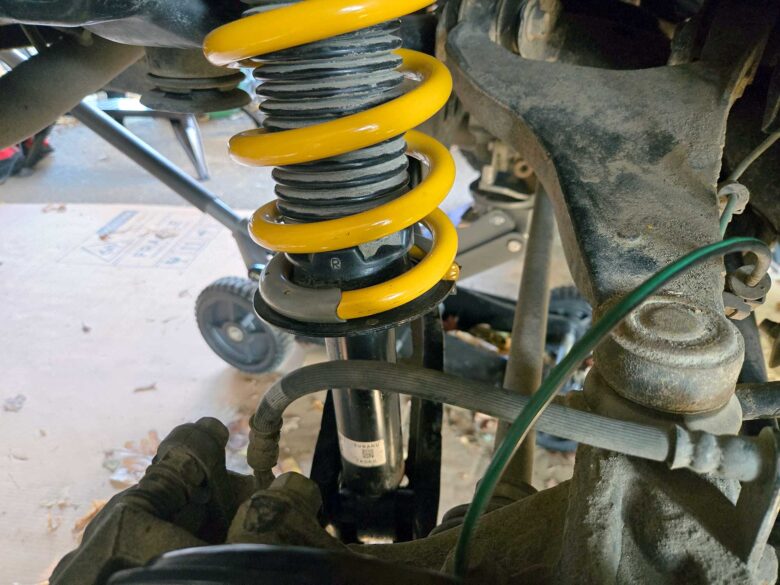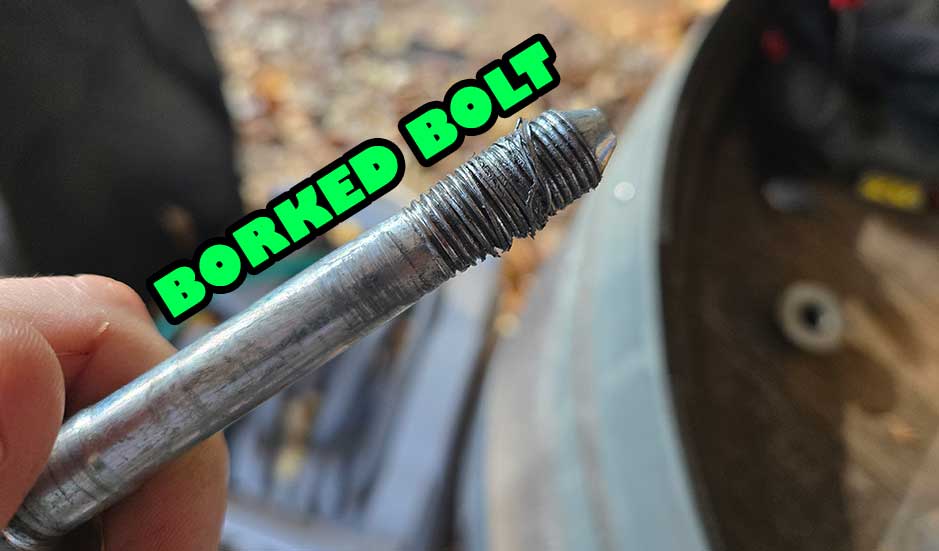Let this be somewhat of a cautionary tale. With the myriad of YouTube mechanics and online automotive experts out there, it can be easy to get bad advice or incorrect bolt torque specs for bolts, for example. Most times, it’s not malicious. But you really need to watch out who you get your info from. Let me explain.
Adding Overload Springs
We’re adding a set of overload rear springs in the form of King Springs from Primitive Racing. These are stiffer and designed to accommodate more weight in or on the vehicle. We had these on the TransAmerica Trail 2025 Subaru Crosstrek Wilderness. Since we’re adding a RiG’d Supply UltraSwing (and some of their accessories), I wanted to get our 2022 Subaru Crosstrek ready for the tire carrier’s added weight.
I’ve replaced struts many times before. I know how to do it. But since every application has its quirks and tricks, the first place I went to was YouTube. There, I found a comprehensive, easy-to-follow video about removing and replacing the rear struts on a 2018–2023 Crosstrek. It all seemed straightforward.
NARRATOR: It was not so straightforward …
Truth be told, it is straightforward, but the process fought me at every step. It was just one of those installs. After sparring with spring clamps and battling bolts, all that was left to do was torque down six bolts: four on the sturts’ tops, and two lower flange bolts on the rear sturts’ eyelets into the lower control arm.
Following A YouTube Video To A Fault
The video suggested the top strut bolts were to be torqued to 24 ft.-lbs., and the lower strut bolts to 89 ft.-lbs. The uppers employ a 14mm wrench, the lowers require a 17mm socket on the nut and a wrench on the bolt so it doesn’t spin. I started with the driver’s side. Once hand-tight, I got out my torque wrench and set it. A few turns and—CLICK—89 ft.-lbs. I move over to the passenger’s side. Hand-tight, torque wrench set, and turn … and turn … and turn. Why isn’t this getting any tighter? I check the bolt, but it’s in place. Then suddenly the nut gets looser, even though I’m going righty-tighty. Shit. This isn’t good.
Begrudgingly, I begin to remove the nut. It’s getting tough to turn—never a good sign. But with enough muscle, it comes off. The nut’s threads are almost gone. I punch out the flanged strut bolt from the lower control arm. The threads are all borked (see lead photo). What the hell is going on?
I’m pissed. No … furious. This has been a beast of a job. It shouldn’t have been. How dumb am I? I can’t even get a bolt tight? What should have been a couple of hours is now going to be a weekend, if not longer.
What Happened?
Now I start to theorize. Maybe I crossthreaded it. But it went on easily enough. I call my friend, Scott. He suggests that perhaps it was put on wrong from the factory. Hey, mistakes happen.
I run to the hardware store. This is an M12 bolt with a long shoulder in an oddly specific length. I’m also not sure if it’s class 8.8 or 10.9. You know what? When in doubt, just get the damn replacement at the dealer. I call multiple Subaru dealers in the Portland area, and all need to order the bolt. And, as the saying goes, “Two is one, and one is none,” I ordered two bolts and two nuts. You know, just in case.
The next day, we go down to the dealership, pick up my hardware, and head home to get this bolt buttoned up.
Round Two: FIGHT
Again, the bolt fights me. It’s a royal pain in the ass to install with the spring under load. With enough pry bar use, white lithium grease, hammering, and cussing, I can finally punch the bolt through the control arm via the strut’s eyelet, having been very cognizant not to mess up the bolt’s threads.
I spin the nut on, use 17mm wrenches to snug it up, then get out Mr. Torque Wrench again. I set it to 89 and turn … and turn … and turn. Now I’m feeling paranoid. I stop. This should be getting tighter by now. Why isn’t it getting tighter? This is a damn nut and bolt, not trigonometry. I stop and unscrew the nut to examine the threads. It all looks good. I snug up the nut again and get the torque wrench. This time, I set it for 70 lb.-ft. CLICK. OK, up to 75. CLICK. Now to 89. Turn … and turn … and turn … and now it’s freely spinning. Damn it! What the bloody hell is going on here?
Now I’m Confused.
Now I’m having all sorts of doubts. I call Scott again, who theorizes with the gusto of an astronaut attempting to fix a multi-billion-dollar space station. I chime in with an idea that perhaps the strut is in backwards, but it shouldn’t matter. Why would that matter? Why does any of this matter?
I go back to my video guide. Again, the presenter states 89 lb.-ft. of torque. I now hunt for verification of this spec. In all my years working on cars, I have never had a harder time finding a legitimate torque spec for something. I found Forester, Outback, WRX, but no Crosstrek! Perhaps my video guide meant 89 newton-meters, which is 65.6 ft.-lbs., but said foot-pounds instead. I mean, honest mistake, right? But nowhere can I find the spec. I stumble across a list of specs from RalliTek, and sure enough, it says 89 ft.-lbs. too.
The night before this abomination of an install, we were on the Auto Off Topic podcast with Brad DeSantis and Andrew Pascarella. Andrew says he actually made a YouTube video for replacing the struts on our generation of Crosstrek. Remembering this, I go check it out. Andrew calls out 60 ft.-lbs. in his video for my bastard bolt. I reach out to him, asking where he got his spec. He says the factory service manual (FSM). This is going to be a car’s bible. I, however, didn’t have a copy, so I went with what a YouTuber suggested.
Mystery Solved?

Well, this would totally make sense. The threads were totally screwed up both times, and it felt like the bolt was yielding.
In one last attempt, I post in a Facebook group, figuring I’d be lambasted for not knowing or being unable to find the right spec online. Someone posted a pic of the FSM indeed showing 59 ft.-lbs. not 89. The photo was accompanied by the comment, “It’s not that hard to find,” to which I replied, “If you know where to look.” Ah, Facebook …
Since I bought the spare bolt and nut (you always buy two), I was able to yet again do battle with the bolt, and would ultimately be victorious, and torqued it successfully to 59 ft.-lbs. Huzzah!
However, now I’m, thinking: how did the driver’s side not get ruined? Out of sheer morbid curiosity, I decided to remove this bolt and inspect it, but not before ordering one more from the dealer. (I still had the original, which looked OK.)
To my surprise, the left-side bolt came off fine, and the threads were in good shape. But, out of an abundance of caution, I ended up installing the new bolt and nut anyway.
The Moral: Trust The FSM, Not YouTubers Or Websites
The moral of the story? The FSM is the single source of truth. This is where the specs should come from. And just because a YouTuber gives you a spec, don’t assume it’s automatically right. Validate it against the FSM. If you don’t have it, find someone who does, even if they belittle you in a group. Or find a screengrab or something. Just don’t blindly follow one person’s advice. Thanks for attending my TED Talk.
As someone who’s tinkered with cars/trucks for about a quarter century now, I should’ve known better. But this was a reminder to make sure you get your info from trusted sources. I was only out about $30 in bolts and nuts. But if this were a head stud or something else, it could’ve been a much more costly ordeal.

Andy Lilienthal is an award-winning writer and has written professionally since 1999. He has over 13 years in the automotive aftermarket working at companies including Warn Industries, Bushwacker, and Lund International. Editorial works include writing and photography for off-road print magazines, to new-car reviews online. He’s a photographer with images in multiple magazines, blog sites, and The New York Times.


Leave a Reply